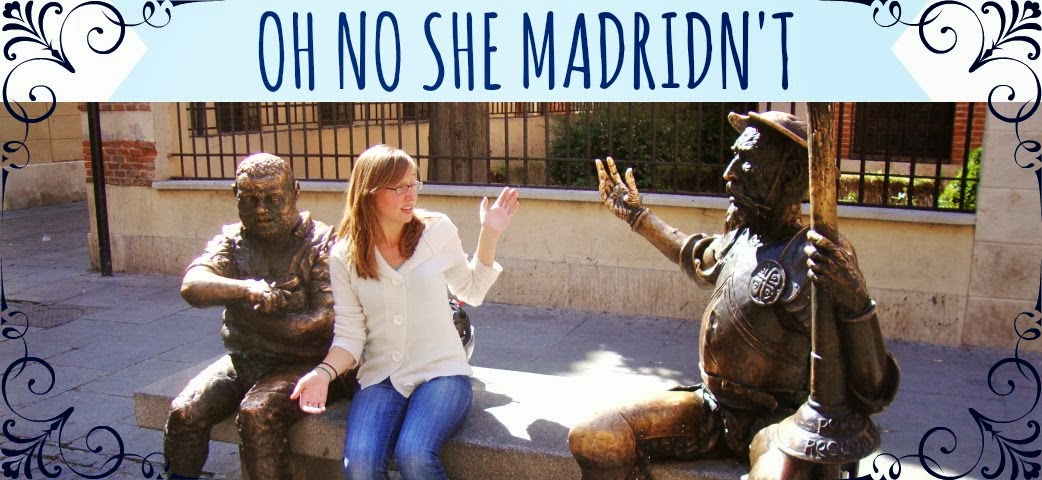After visiting Park Güell on Saturday morning, I took the 2:30 Gothic tour with Take Me Out. I learned so many interesting pieces of information that I wouldn't have learned otherwise (which I'll share with you below), and got to cross off many sites from my AAA pages - all with zero planning on my part. Score!
Plaza Real
Both tours began in the Plaza Real.Notice the palm trees in the plaza. Turns out the palm trees were added to the plaza for the 1992 olympics. The trees were a gift from a Catalan family that now lives in the Caribbean: the Bacards. Our tour guide asked what we thought the Bacards might be famous for, and the only word that came to my head was Bacardi, drilled into my head from In Da Club's lyrics. I must have let a smile slip when I had this thought, because our tour guide then says to me, "It looks like you might have an idea." "Bacardi?" I guessed. Yup!
Los Caracoles
Our next stop was Los Caracoles, an apparently super famous restaurant.It's been around since 1835, which adds to its fame. Apparently if a famous person or political figure were visiting the city, this is somewhere they would probably eat.
Los caracoles means "snails," but many tourists think it means "chicken" because there are normally rotisserie chickens being cooked on flames behind the gate you see above.
George Orwell Plaza
We then walked to the George Orwell plaza. George Orwell (author of Animal Farm and 1984) moved to Barcelona during the Spanish civil war, where he wrote and actually fought against the fascists. He later wrote about his experiences in the book Homage to Cataluña.In 1937 while fighting on the front, Orwell was shot through the throat and nearly died. Apparently that's what's depicted in the above sculpture in the plaza: Orwell getting shot in the throat. Meh, it's art.
I guess this plaza isn't well known as the "George Orwell plaza" by locals; it was a place where drugs were often sold, and referred to as "plaza trippy". To battle the drugs, the city added two things: a children's park and surveillance cameras. So it's quite ironic that the plaza dedicated to Orwell, the man against big-brother government, is one of the few public places in Barcelona under video surveillance.
Our guide also mentioned that if you're looking for vegan or vegetarian food, this plaza had a couple restaurants he'd recommend.
Escuela de artes aplicadas y oficios artísticos
 |
| Escuela de artes aplicadas y oficios artísticos in Barcelona |
Not far from the George Orwell plaza was the school of applied arts and artistic offices. Picasso studied at this school when he was younger. Part of the roof collapsed in 2009 and it's been closed ever since (there's a gate around the entrance, preventing you from going in).
Citizens were upset that the school was closed, and that a higher priority hadn't been placed on fixing the ceiling. So naturally, they expressed their dislike of the situation by dumping paint on the front door of the school:
This will obviously make it take even longer until the school has enough funds to get fixed up and reopen, but hey, what's done is done.
Space Invader
If you turn around, your back facing the school, you'll see a blue space invader on the opposite wall, to the right of the "Carrer de Cervantes" street sign.There's a famous French street artist, Space Invader, who is known for his mosaics of the classic arcade game. Our tour guide told us that to his knowledge, Invader had never been caught; nobody knew who he was, and he'd put up space invaders in cities across the world.
Roman Wall
We walked past a 1600 year old Roman wall. Throughout the tour, our guide focused on the theme that Barcelona mixes new with the old. Rather than tearing down and rebuilding, they built right on top of the old and incorporate it into the new.Santa María del Mar
The Santa María del Mar is a church that was built by peasants of Barcelona between 1329 and 1383, with no help from the king.
 |
| Santa María del Mar |
In 1428 windows broke during an earthquake that would have measured 8 on the Richter scale. The windows were replaced, but later during the Spanish civil war the church was burned. The interior has since been fixed, but you can still see burn marks on the stone ceiling.
Barcelona Cathedral
The other main church in town is the Barcelona Cathedral.
I really loved the ceiling inside.
Take Me Out tours
There were other stops on the tour as well, but those are all I'll share here. The tour lasted about two hours total, and I was very pleased with all I had learned and seen. Since these tour guides don't get paid for the walking tours, they ask for tips at the end. You give whatever you can, and whatever you think it was worth. I liked the Gothic tour better than the Gaudí tour I took the next day, so I tipped more on the Gothic tour.
Again, the group was called "Take Me Out" tours, and they stopped by a bunch of hostels to pick up people for each tour. If they don't stop by your hostel, you can always just go to the Plaza Real around 10:30 or 3 and look for guys with water bottles talking in English to groups of people. Anyone is welcome to join the tours.
 |
| My tour guide, the Canadian |











Thanks, I'll probably be asking you a question or two at some point in the future.
ReplyDeleteReading your great posts and seeing the beautiful architecture in your pictures draws me to Spain even more.